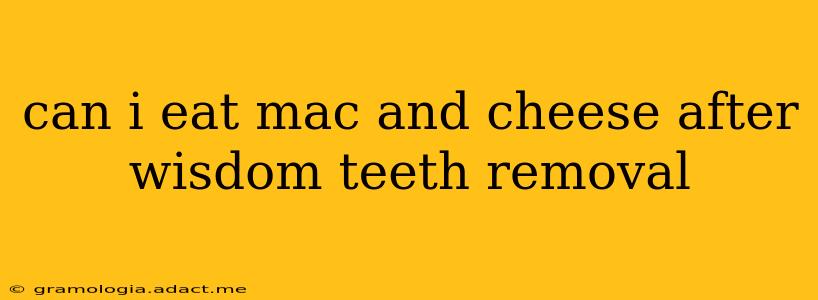Can I Eat Mac and Cheese After Wisdom Teeth Removal? A Guide to Post-Surgery Diet
Having your wisdom teeth removed is a significant procedure, and your diet plays a crucial role in your recovery. One of the first questions many patients ask is, "Can I eat mac and cheese after wisdom teeth removal?" The answer is a bit more nuanced than a simple yes or no. Let's delve into the details to ensure you're making the best choices for a smooth recovery.
What Can I Eat After Wisdom Teeth Removal?
Immediately following wisdom teeth extraction, your diet will be restricted to very soft foods. This is because chewing can disrupt the blood clots forming in the extraction sites, potentially leading to dry socket, a painful complication. Initially, you'll likely be limited to things like:
- Liquids: Broth, smoothies (without seeds or chunks), and protein shakes.
- Pureed Foods: Applesauce, yogurt (without chunks), and mashed potatoes.
- Soft Foods: Scrambled eggs (well-cooked), pudding, and very soft oatmeal.
As the healing progresses (typically after a few days), you can gradually introduce more substantial foods, but they should still be soft and easy to swallow.
Is Mac and Cheese Okay After Wisdom Teeth Removal?
This depends heavily on the consistency of the mac and cheese. Creamy, well-cooked mac and cheese can be a good option after the initial few days of recovery and only if it's very soft and doesn't require much chewing. However, there are important considerations:
- Avoid crunchy noodles: The noodles in your mac and cheese should be extremely soft and almost melt in your mouth. Any hard or crunchy bits could dislodge a blood clot.
- Check for chunks of cheese: Large pieces of cheese are a no-go. Ensure the cheese is fully melted and incorporated into the sauce.
- Consider the temperature: Avoid extremely hot mac and cheese, as this could irritate the extraction sites. Let it cool down to a lukewarm temperature before eating.
- Listen to your body: If it hurts to eat the mac and cheese, stop immediately. Pain is your body’s way of telling you something isn't right.
What Are the Best Foods to Eat After Wisdom Teeth Removal?
Focusing on nutrient-rich foods that are gentle on your mouth is key. Some excellent choices include:
- Protein shakes: Provide essential protein for healing.
- Yogurt: A good source of calcium and probiotics for gut health.
- Smoothies: Easy to consume and can be packed with fruits, vegetables, and protein.
- Mashed sweet potatoes: A soft, nutritious option.
- Scrambled eggs: A great source of protein.
What Foods Should I Avoid After Wisdom Teeth Removal?
Avoid these foods during your recovery to prevent complications:
- Hard foods: Anything that requires significant chewing.
- Spicy foods: Can irritate sensitive gums.
- Acidic foods: Can cause discomfort.
- Foods with small seeds or nuts: These can easily get lodged in the extraction sites.
- Straws: Sucking through a straw can dislodge blood clots.
How Long Should I Avoid Certain Foods After Wisdom Teeth Removal?
The timeframe for dietary restrictions varies depending on individual healing and the complexity of the procedure. However, most people can gradually reintroduce more solid foods after a week. Always follow your oral surgeon's specific instructions.
Can I Eat Mac and Cheese with a Lot of Cheese?
No, as previously mentioned, excessive amounts of cheese that haven't melted completely are not recommended. Stick to a smooth, creamy consistency.
Should I Blend My Mac and Cheese?
Blending your mac and cheese isn't strictly necessary, but it's a good way to ensure a super-smooth consistency if you're concerned about any potential bits of noodles or cheese.
Remember, your oral surgeon is the best source of information regarding your post-operative diet. This information is for general knowledge and should not replace professional medical advice. Always follow their recommendations for a successful and comfortable recovery.
